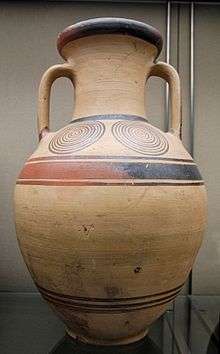Protogeometric art

| Part of a series on the |
| History of Greek art |
|---|
.jpeg) |
| Greek Bronze Age |
| Ancient Greece |
| Medieval Greece |
| Post-Byzantine Greece |
| Modern Greece |
The Protogeometric style is a pottery type associated with the Greek Dark Ages. After the collapse of the Mycenaean-Minoan Palace culture and the ensuing Greek Dark Ages, the Protogeometric style emerged around the mid 11th century BCE as the first expression of a reviving civilization. Following on from the development of a faster potter's wheel, vases of this period are markedly more technically accomplished than earlier Dark Age examples. The decoration of these pots is restricted to purely abstract elements and is best characterized by broad horizontal bands about the neck and belly and concentric circles applied with compass and multiple brush.
Some of the innovations included some new Mycenean influenced shapes, such as the belly-handled amphora, the neck handled amphora, the krater, and the lekythos. Attic artists redesigned these vessels using the fast wheel to increase the height and therefore the area available for decoration.
See also
References
- Murray, R. L. The Protogeometric Style: the first Greek style (1975).
- Eiteljorg, H., "The fast wheel, the multiple brush compass and Athens as home of the Protogeometric style" American Journal of Archaeology (AJA) 84 (1980) pp. 445–452.
External links
- Greek Art & Archaeology, (Japanese and English)
- Introduction to the Ancient World: Greece, University of Texas at Austin